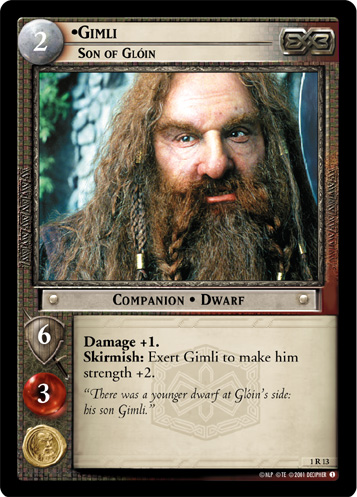| LotR TCG Wiki | → Card Sets: | All | 0 | 1 | 2 | 3 | 4 | 5 | 6 | 7 | 8 | 9 | 10 | 11 | 12 | 13 | 14 | 15 | 16 | 17 | 18 | 19 | → Forums: | TLHH | CC |
The Lord of the Rings TCG Wiki: Vitality
Vitality
Vitality is the “health” of a character; once the vitality reaches 0 that character is killed and removed from play (moved to the Dead Pile if a companion or ally, moved to the Discard Pile if a minion). Damage can come from a variety of sources, from archery fire and skirmish wounds to voluntary exertion. Regardless of source, all damage is measured by placing damage tokens on the card (usually blood-red beads).
Damage from exertion and damage from wounds are distinct. Wounds can, of course, be lethal; exertion, on the other hand, is almost always voluntary, but cannot be performed if the character is exhausted (which is to say, one vitality away from dying). Again, once the action is performed, damage is damage and they are not further differentiated.
Besides being important in battle (so one can suffer more hits before dying), many abilities are activated with an exertion, so sometimes a low-strength high vitality character can be extremely worthwhile, not for battle prowess but for flexibility. Some cards such as the infamous ”Shotgun Enquea” are only so devastating because of their high vitality in combination with strong abilities, and not because of other factors, such as strength.
Average vitality amounts vary from culture to culture, but are usually fairly consistent (with obvious outlying exceptions). Moria orcs, for instance, tend to be around 1 - 2, other Orcs and Uruk-hai range from 1 - 3, Dwarves and Men around 3, and Hobbits around 4. There are always exceptions, but these misfits are almost always extremely expensive for their race.
Artifacts, possessions or conditions that modify vitality are uncommon, especially when compared to modifiers for strength, the other major character attribute. This is especially true for minions; Wargs make up the majority of examples for the Shadow side. Rings of Power will more often than not offer a vitality bonus. See the bottom of this article for other examples.
If a character is exhausted and a vitality-boosting card is removed, they are instantly killed (and with no new wounds being added, this makes this type of death particularly difficult to prevent). As you can see, it's therefore dangerous to rely too much on items for vitality; it's fairly easy to have them removed and if your opponents sees an opportunity to kill one of your characters by simply discarding a card, they'll do it.
It should be noted that if a card ever mentions spotting a character with X vitality, that is the current vitality, not the maximum vitality. An exhausted Aragorn cannot fulfill the cost of “Spot a man with 3 or more vitality”, for instance.
There are many strategies based around healing damage rather than mitigating it; see the main article on healing for more information.
See Also Skirmish phase, killed, overwhelmed,

Gimli here has an average vitality at 3. His ability is only available so long as he has 1 or fewer wounds, so it pays to keep his vitality up.
From the Comprehensive Rules 4.0:
All characters in the game have vitality. This number represents a character’s life force, stamina, sturdiness, and will to live.
Each wound token on a character depletes that character’s vitality by 1.
See also exhausted, killed.